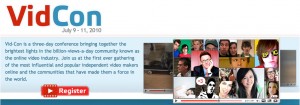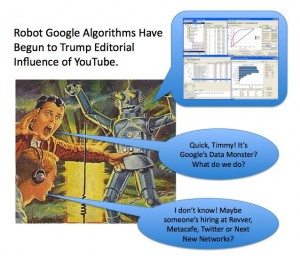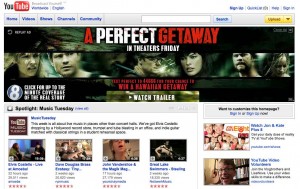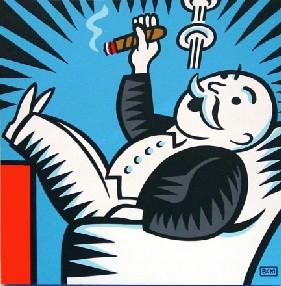{Update from 2013 reveals YouTube stars making $4 million plus per year}
How much do YouTube stars make each year? Oh for goodness sakes. Just like my same 5 YouTube videos (see right column of channel page here) represent the majority of my online views… It seems that most of WillVideoForFood’s blog traffic comes from people searching for how much YouTubers make. If you’re curious, read on. If you want to make big bucks, buy my book first. You’ll still be facing tough odds, but at least you’ll wander into the jungle equipped with some survival tools.
We YouTube “Partners” (or “stars” as I hate saying) are all contractually forbidden to share our revenue. But I’ve given hints and clues over time. For those of you who Googled your way here, I’m both a marketer/advertiser and a creator/YouTuber, so that gives me two lenses into this Da Vinci-Code like mystery. Davinci made me think of “Da Bears.”
I’d estimate there are have at least a few dozen YouTube Partners earning $100K per year. That’s great money if you’re in your 20s or 30s and have minimal costs in production or overhead (like 4 kids and a horrific mortgage). But it’s a rounding error for a professional content creator or network.
To calculate a particular Parner’s income, here are some tips:
- You basically take the Partner’s total views for the month, multiply it by a fraction of a penny, and you have a rough idea. TubeMogul‘s Marketplace shows some of the most-viewed people (and their monthly views). But remember: the most-subscribed are not necessarily most-viewed and vice versa. YouTube doesn’t give a hoot how many subscribers you have (although that certainly helps drive views, but increasingly it seems less powerful than being a “related video”). In general, the commercial content is getting more daily views but the amateurs have a lock on subscribers.
- Most ads are placed by advertisers based on total 1K views, but some is on a per-click basis (CPC text ads placed by Google Adwords/Adsense). Google/YouTube is usually paid by an agency or media buyer a CPM (cost per thousand, say between $5 and $25 dollars per thousand views), then shares some of that with the creator. This can be highly misleading, because:
- Some views earn nothing (if they’re embedded and no ad follows it).
- And increasingly advertisers are paying a high premium for specific content they commission, target, or hand select. Sometimes this might average a few bucks and others it might be much higher… $25 CMP was the published rate of InVideo ads and I know of specific integrated campaigns that command a higher premium from YouTube. Yey!
- Another confounding variable: potty-mouthed creator turns away advertisers. So watch the ads on your Partner for a while. Are they premium InVideo ads with accompanying display (square) ads? Or are they garbage Adwords/Adsense ads?
- The text ads may SOMETIMES be paid on a per-click basis, which can make them fruitless or profitable depending on people clicking and buying the advertiser’s product (the latter must occur, or a savvy advertiser will quickly stop the campaign that’s raping them of click dollars and not generating business). I was telling my YouTube buds to turn these off because they’re ugly and don’t make much money, but a few of them gave me a stern stare like they knew otherwise. So whatever… maybe they make money and maybe they don’t. I don’t get a breakdown on them, and they’re still ugly.
- Then you have to factor in “sponsored videos,” where a YouTuber promotes a product or service for a flat fee (or variable based on views) via Hitviews or related companies. That can easily be more than YouTube shells out per month for ad sharing. The going rate here is incredibly wide: from $1K to $20K and higher per video.
So in conclusion:
- Do your own math using monthly views on TubeMogul and assuming some CPM (cost per thousand), but recognize YouTube takes a cut and some of the advertising inventory isn’t sold or is driven by keyword Google adsense text thingies. Maybe the creator/partner gets a few bucks per thousand views and maybe more or less.
- Use some of the assumptions above to calibrate your estimate if you’re trying to peak into the W-9s of your favorite “Stars” like Fred. There are now dozens of popular YouTube people that make a full-time living on YouTube revenue, and I’d guess a lot of $50K-$100K per year people. I am not among the full-timers. With a family of 6, I gotta have a day job too. But Shaycarl, Sxephil, Charles Trippy, Michael Buckley and many more… they’re full-time at this. If I was making the bucks I’m making via YouTube after college, I’d probably go full-time too. Fred? Let’s just say he’s got college covered, or a nice nest-egg.
- Before you get excited (or jealous), it’s a long haul to cashville. And if you start with the hope of making money, you’re doomed. You need to LOVE it, and be extremely patient as the road to loads of views is tougher to climb, and requires an ass-load of persistence. Start as a hobby and “just keep swimming.”
- Finally, there are two forces at odds that impact the sustainability of this revenue for YouTube amateurs. First, we’ll probably see continued competition from more professionally-produced content that fetches higher ad dollars because it feels safer to squeamish media buyers (see, I’m not calling them all dense anymore… only the ones that don’t read this vlog). But the good news is that dollars are projected to grow dramatically. Currently, as a marketer, I’d argue that YouTube is selling itself short.
How’s that? About as specific I can be without breaking my contract or confidence from my friends.
I know some of you peeps know more than I do, so feel free to comment below anonymously or not. Da bears.




 Read Larry’s
Read Larry’s 



 Every day, I run across FEAR of marketing on the Web. We’ve got to work together to help people overcome this fear in 2010.
Every day, I run across FEAR of marketing on the Web. We’ve got to work together to help people overcome this fear in 2010.




